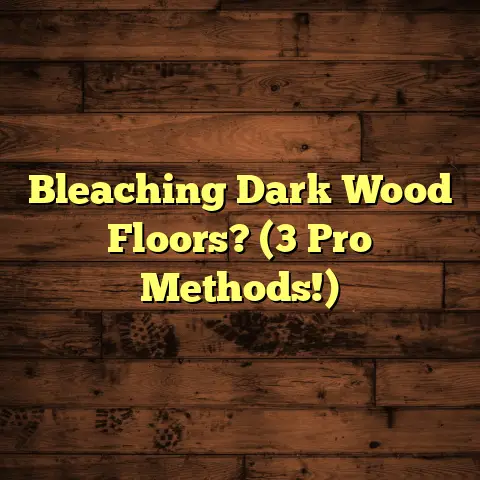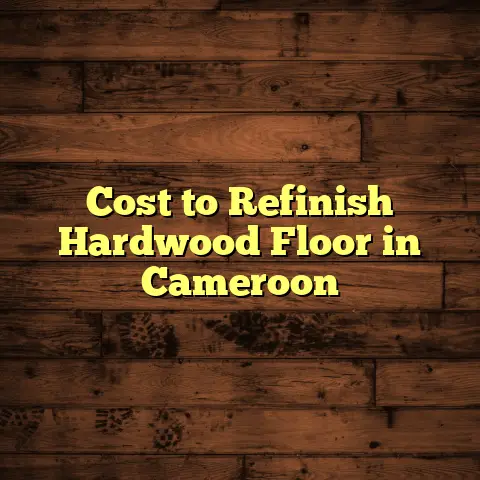Laminate in Kitchens? (7 Things Installers Won’t Say!)
(7 Things Installers Won’t Say!)
It’s your friendly neighborhood flooring contractor here. I’ve been laying down floors for over 15 years, and I’ve seen it all – from gorgeous hardwoods to resilient tiles.But today, we’re diving deep into the world of laminate flooring, specifically in the heart of the home: the kitchen.
Laminate’s become a real contender because it mimics the look of those high-end materials like hardwood, stone, and tile, but without the wallet-busting price tag. Plus, it’s known for being pretty darn durable and easy to clean – a major win in a busy kitchen!
However, here’s the thing: while I love a good laminate floor, there are some real truths that installers like myself don’t always shout from the rooftops. And that’s what this article is all about.
I’m here to pull back the curtain and give you the inside scoop on what to really expect when choosing laminate for your kitchen.
Think of me as your flooring confidant, spilling the beans so you can make the smartest, most informed decision for your home.
So, grab a cup of coffee (or tea!), settle in, and let’s get started!
Section 1: The True Cost of Laminate in Kitchens
Okay, let’s talk money. You see that attractive price tag on the laminate flooring at the store? That’s just the beginning, my friend.
It’s like buying a car – the sticker price is never the actual price, right?
So, what’s the true cost? Well, you’ve got the material itself, sure. Laminate can range anywhere from $1 to $5 per square foot, depending on the quality, thickness, and design.
Then there’s the installation. Now, this is where things can get a little tricky. If you’re a DIY whiz, you might save some cash by tackling the install yourself.
But honestly? Kitchens can be tricky with all those corners, cabinets, and appliances. Unless you’re super confident, I recommend hiring a pro. Installation can add another $2 to $5 per square foot, depending on the complexity of the job.
But wait, there’s more!
Here’s where those “hidden” costs creep in:
-
Underlayment: This is a must! It provides cushioning, sound dampening, and, most importantly, a moisture barrier. Don’t skimp on this. Expect to pay around $0.50 to $1 per square foot.
-
Moisture Barrier (Extra): Especially in kitchens, I always recommend an additional moisture barrier, even with underlayment that claims to have one built in. Think of it as extra insurance. It will cost you around $0.30 to $0.70 per square foot.
-
Specialized Tools: You might need a tapping block, pull bar, and a good quality saw. You might already have these, but if not, factor in those costs.
-
Subfloor Prep: This is huge! If your subfloor isn’t level, you’re going to have problems. Leveling can add significant cost, depending on the extent of the issue. I’ve seen subfloor prep cost anywhere from $1 to $5 per square foot.
-
Trim and Molding: Don’t forget baseboards, quarter-round, and transition strips. These add the finishing touch, but they also add to the budget.
Let’s break it down with an example:
Imagine you have a 200-square-foot kitchen:
- Laminate Flooring: $3 per sq ft = $600
- Installation: $3 per sq ft = $600
- Underlayment: $0.75 per sq ft = $150
- Extra Moisture Barrier: $0.50 per sq ft = $100
- Subfloor Leveling (Moderate): $2 per sq ft = $400
- Trim and Molding: $150
Total: $2000
See how quickly it adds up?
Now, let’s compare that to other flooring options.
| Flooring Type | | :———————– | :———————————————————————————————————- | | Laminate | $3 – $10 | | Tile | $5 – $20 | | Hardwood | $8 – $25 | | Vinyl Plank | $3 – $12 |
These prices are estimates and can vary based on location, material quality, and installation complexity.
As you can see, laminate is generally more affordable than hardwood or tile, but it’s comparable to vinyl plank.
The key takeaway here is to get a detailed quote from your installer, asking about all potential costs. Don’t be afraid to ask questions and clarify anything that seems vague.
Understanding the total investment upfront will save you from unpleasant surprises down the road.
Section 2: Durability Myths
Laminate flooring is often touted as being super durable, and in some ways, that’s true. It can definitely withstand daily wear and tear, especially compared to something like carpet.
But let’s bust some myths, shall we?
Myth #1: Laminate is Scratch-Proof
Nope. Not even close. While laminate has a protective wear layer, it’s not impervious to scratches.
Dragging furniture, pets with long claws, and even just everyday foot traffic can leave their mark over time.
The Abrasion Class (AC) rating of laminate determines its scratch resistance.
- AC1: Suitable for bedrooms and closets.
- AC2: Suitable for living rooms and dining rooms.
- AC3: Suitable for all residential uses and light commercial use.
- AC4: Suitable for general commercial use.
- AC5: Suitable for heavy commercial use.
For kitchens, I always recommend AC3 or higher.
Myth #2: Laminate is Waterproof
Big, fat NO. Laminate is water-resistant, not waterproof. That means it can handle spills if you clean them up quickly. But standing water? Forget about it. It will seep into the seams and cause swelling and warping.
I’ve seen so many kitchens ruined by leaky dishwashers or overflowing sinks. It’s heartbreaking!
Myth #3: Laminate is Heat-Resistant
Again, not really. While it can handle some heat, like from a warm dish, placing a hot pan directly on the laminate will likely cause damage. Always use trivets and hot pads.
So, what are the limitations?
-
Scratches: As mentioned, scratches are a reality. Use floor protectors under furniture legs and be mindful of what you’re dragging across the floor.
-
Water Damage: This is the biggest concern. Clean up spills immediately and be extra cautious around sinks and appliances.
-
Fading: Prolonged exposure to direct sunlight can cause laminate to fade over time. Use curtains or blinds to protect your floors.
What types of laminate are best suited for kitchens?
Look for:
- High AC Rating: AC3 or higher for better scratch resistance.
- Thick Wear Layer: A thicker wear layer will provide more protection.
- Water-Resistant Core: Some laminates have a specially treated core that offers better moisture resistance.
- Beveled Edges: Beveled edges can help prevent water from seeping into the seams.
How can you protect your laminate floors from damage?
- Use Doormats: Place doormats at entrances to trap dirt and debris.
- Clean Regularly: Sweep or vacuum regularly to remove dirt and grit.
- Use the Right Cleaning Products: Avoid harsh chemicals and abrasive cleaners. Use a laminate-specific cleaner.
- Trim Pet Nails: Keep your pet’s nails trimmed to minimize scratching.
- Be Careful with Water: Clean up spills immediately and avoid excessive moisture.
I always tell my clients that laminate is a great option, but it’s not a miracle product. It requires care and maintenance to keep it looking its best.
Section 3: Moisture Concerns and Kitchen Environments
Alright, let’s tackle the elephant in the room: moisture. Kitchens are notorious for being moisture-prone areas.
Think about it: you’ve got the sink, the dishwasher, spills happening all the time, and maybe even a leaky fridge.
Water is laminate’s worst enemy. I can’t stress this enough.
Why is laminate often viewed as less favorable than other materials in moisture-prone areas?
Well, unlike tile or vinyl, laminate is made of a wood composite core. When water seeps into that core, it swells, warps, and basically ruins the floor.
Once that happens, there’s no going back. You’re looking at a full replacement.
The Importance of Quality and Underlayment
The quality of the laminate itself plays a huge role in its moisture resistance. Cheaper laminates tend to have a less dense core, making them more susceptible to water damage.
That’s why I always recommend investing in a higher-quality laminate with a water-resistant core. It’s worth the extra money in the long run.
And then there’s the underlayment. This is your first line of defense against moisture.
Choose an underlayment that is specifically designed for laminate flooring and has a built-in moisture barrier.
I often recommend using a separate moisture barrier film, even with an underlayment that claims to have one. It’s just an extra layer of protection that can make a big difference.
Installer Experiences and Mitigation
I’ve seen firsthand the devastation that moisture can cause to laminate floors. I had one client who installed laminate in their kitchen, and within a year, the floor was completely ruined due to a slow leak under the dishwasher.
The laminate had swollen and buckled, and the entire floor had to be replaced.
That’s why I’m so adamant about proper moisture protection.
How can homeowners mitigate these risks?
- Choose the Right Laminate: Opt for a high-quality laminate with a water-resistant core.
- Use a Moisture Barrier: Install a separate moisture barrier film underneath the underlayment.
- Seal the Seams: Consider using a seam sealer to prevent water from seeping into the seams between the planks.
- Be Vigilant: Keep an eye out for leaks and spills, and clean them up immediately.
- Proper Ventilation: Ensure good ventilation in the kitchen to reduce humidity levels.
- Consider Alternatives: If you’re really concerned about moisture, consider alternatives like vinyl plank or tile.
Quotes from Installers
I spoke with a few other installers to get their thoughts on moisture and laminate flooring in kitchens.
-
“I always tell my clients that laminate is like a sponge. If you let it soak up water, it’s going to expand and ruin the floor.” – John S.
-
“The biggest mistake I see is people not using a proper moisture barrier. They think the underlayment is enough, but it’s not.” – Maria L.
-
“I’ve had to replace so many laminate floors due to water damage. It’s heartbreaking because it could have been prevented with proper precautions.”
- David B.
The bottom line? Moisture is a serious concern when it comes to laminate flooring in kitchens. Take the necessary precautions to protect your floors, and you’ll be much happier in the long run.
Section 4: Installation Challenges
So, you’ve decided on laminate for your kitchen. Great! But before you start ripping up your old floors, let’s talk about the installation process.
This is where things can get a little tricky, and it’s where installers might not always be completely upfront about the challenges involved.
Subfloor Preparation
I mentioned this earlier, but it’s worth repeating: subfloor preparation is crucial. If your subfloor isn’t level, clean, and dry, you’re going to have problems.
Uneven subfloors can cause the laminate to flex and creak, and they can also lead to premature wear and tear.
Before installing laminate, you need to make sure your subfloor is:
- Level: Use a leveling compound to fill in any low spots or grind down any high spots.
- Clean: Remove any dirt, debris, or old adhesive.
- Dry: Make sure the subfloor is completely dry before installing the laminate. Use a moisture meter to check the moisture content.
Leveling Issues
Leveling a subfloor can be a real pain, especially in older homes where the subfloor might be significantly uneven.
It can involve multiple layers of leveling compound and a lot of time and effort.
I had one job where the subfloor was so uneven that I had to use a self- leveling underlayment. It added a significant cost to the project, but it was the only way to ensure a smooth, level surface for the laminate.
Cutting Around Cabinets and Appliances
Kitchens are full of obstacles: cabinets, appliances, islands, and so on. Cutting laminate around these obstacles can be tricky, especially if you’re not experienced.
You need to be precise with your measurements and cuts to avoid gaps and unsightly seams.
I recommend using a jigsaw with a fine-tooth blade for making curved cuts around cabinets and appliances.
Expansion Gaps
Laminate flooring expands and contracts with changes in temperature and humidity. That’s why it’s important to leave an expansion gap around the perimeter of the room.
This gap allows the laminate to move without buckling or warping.
Most manufacturers recommend leaving a 1/4- to 3/8-inch expansion gap. This gap will be covered by baseboards or quarter-round molding.
Tapping Blocks and Pull Bars
When installing laminate, you’ll need a tapping block and a pull bar to ensure a tight fit between the planks.
A tapping block is used to gently tap the planks together, while a pull bar is used to pull the last row of planks into place.
These tools are essential for achieving a professional-looking installation.
Tips for a Seamless Experience
- Read the Instructions: Always read the manufacturer’s instructions before starting the installation.
- Acclimate the Flooring: Allow the laminate to acclimate to the room’s temperature and humidity for at least 48 hours before installation.
- Plan Your Layout: Plan the layout of the flooring to minimize waste and ensure a visually appealing result.
- Use the Right Tools: Make sure you have all the necessary tools before starting the installation.
- Take Your Time: Don’t rush the installation process. Take your time and pay attention to detail.
What Homeowners Should Expect
- Dust and Debris: Expect some dust and debris during the installation process. Cover furniture and other items to protect them.
- Noise: The installation process can be noisy, especially when cutting the laminate.
- Time: Depending on the size of your kitchen and the complexity of the job, the installation can take anywhere from one to three days.
By being prepared for these challenges and following these tips, you can ensure a smoother, more successful laminate flooring installation in your kitchen.
Section 5: Aesthetic Limitations
Laminate flooring has come a long way in terms of aesthetics. You can now find laminate that looks remarkably like real hardwood, stone, or tile.
But let’s be honest, there are still some limitations.
Design Choices
While the range of styles available is vast, laminate can’t perfectly replicate the natural variations and textures of real materials.
For example, with hardwood, each plank is unique, with its own grain pattern and color variations. Laminate, on the other hand, often has repeating patterns, which can make it look less authentic.
Authenticity
That’s not to say that laminate can’t look good. It definitely can! But if you’re looking for the exact look and feel of real wood or tile, laminate might not be the best choice.
Insights from Designers and Installers
I spoke with a few designers and installers to get their thoughts on choosing the right laminate for a kitchen’s overall design.
-
“When choosing laminate, pay attention to the texture. Some laminates have a textured surface that mimics the look and feel of real wood or tile. This can make a big difference in the overall appearance.” – Sarah M., Interior Designer
-
“Consider the color and style of your cabinets and countertops. Choose a laminate that complements these elements to create a cohesive look.”
- Tom B., Flooring Installer
-
“Don’t be afraid to mix and match laminates. You can use different colors or styles to create a unique and interesting design.” – Lisa K., Interior Designer
How to Choose the Right Laminate
- Consider Your Style: What is the overall style of your kitchen? Traditional, modern, rustic? Choose a laminate that fits your style.
- Think About Color: Light colors can make a small kitchen feel larger, while dark colors can add warmth and sophistication.
- Pay Attention to Texture: Look for laminates with a textured surface to mimic the look and feel of real materials.
- Consider the Plank Size: Larger planks can make a small kitchen feel more spacious.
- Get Samples: Always get samples of the laminates you’re considering and see how they look in your kitchen’s lighting.
Compromises
Ultimately, choosing laminate is about making compromises. You’re trading some of the authenticity of real materials for affordability and durability.
But with careful planning and the right choices, you can still create a beautiful and functional kitchen floor with laminate.
Section 6: Maintenance Realities
One of the biggest selling points of laminate flooring is its ease of maintenance. And it’s true, laminate is generally easier to clean than carpet or hardwood.
But let’s talk about the realities of maintaining laminate flooring in a kitchen.
Cleaning Routines
The key to keeping your laminate floors looking their best is to clean them regularly.
- Sweep or Vacuum: Sweep or vacuum your floors regularly to remove dirt, dust, and debris.
- Mop: Mop your floors with a laminate-specific cleaner. Avoid using excessive water, as this can damage the laminate.
- Clean Spills Immediately: Clean up spills immediately to prevent staining and water damage.
Harmful Products
Avoid using harsh chemicals, abrasive cleaners, and steam mops on laminate flooring. These can damage the wear layer and dull the finish.
Wear Over Time
While laminate is durable, it’s not indestructible. Over time, it can show signs of wear and tear, especially in high-traffic areas.
Scratches, scuffs, and fading are all common issues.
Maintaining Appearance and Function
- Use Doormats: Place doormats at entrances to trap dirt and debris.
- Use Floor Protectors: Use floor protectors under furniture legs to prevent scratching.
- Clean Regularly: Sweep or vacuum regularly to remove dirt and grit.
- Use the Right Cleaning Products: Avoid harsh chemicals and abrasive cleaners. Use a laminate-specific cleaner.
- Trim Pet Nails: Keep your pet’s nails trimmed to minimize scratching.
- Be Careful with Water: Clean up spills immediately and avoid excessive moisture.
Installer Experiences
I’ve seen a lot of laminate floors that have been neglected and abused. And it shows.
With proper care and maintenance, laminate flooring can last for many years. But without it, it can quickly deteriorate.
Section 7: Trends and Innovations
The world of laminate flooring is constantly evolving. New technologies and designs are emerging all the time.
Advances in Technology
- Waterproof Laminate: Some manufacturers now offer waterproof laminate flooring. This is a game- changer for kitchens, as it eliminates the worry about water damage.
- Enhanced Textures: New manufacturing techniques are allowing for more realistic textures that mimic the look and feel of real wood and tile.
- Improved Durability: Laminate flooring is becoming more durable than ever before, with improved scratch and stain resistance.
Emerging Design Trends
- Wide Planks: Wide planks are becoming increasingly popular, as they can make a room feel more spacious.
- Gray Tones: Gray tones are a popular choice for modern kitchens.
- Wood-Look Laminate: Laminate that mimics the look of real wood is still a popular choice.
Installer Perspectives
I asked a few other installers how these trends are changing the landscape of kitchen flooring.
-
“Waterproof laminate is a game- changer. It’s making laminate a more viable option for kitchens, where moisture is always a concern.”
- Mark T.
-
“The improved textures are amazing. You can now get laminate that looks and feels just like real wood.” – Jessica R.
What to Keep an Eye On
- Waterproof Technology: Keep an eye on the development of waterproof laminate technology. This is the future of kitchen flooring.
- Sustainable Materials: Look for laminates that are made from sustainable materials.
- Easy Installation: Choose laminates that are easy to install, especially if you’re planning on doing it yourself.
Conclusion
So, there you have it – the inside scoop on laminate flooring in kitchens.
We’ve covered the true cost, the durability myths, the moisture concerns, the installation challenges, the aesthetic limitations, the maintenance realities, and the latest trends and innovations.
I hope this article has given you a better understanding of what to expect when choosing laminate for your kitchen.
Remember, while laminate can be a fantastic choice, it’s important to be informed about the realities, challenges, and hidden truths that come with this material.
Do your research, consult with professionals, and make the best choice for your kitchen flooring needs.
And as always, happy flooring!





